|
|
By Casey Ellis, CTO and Founder of Bugcrowd
Cyber experts levelling the playing field and disrupting threat actors
In technology circles, it’s a well-known and often lamented fact that technology and cybersecurity have a habit of moving at a much faster pace than policy. “Hackers on the Hill” (HotH) is a program that works to bridge this gap by bringing hackers and policymakers together to address technology policy matters, learn how to understand and communicate with each other more effectively, and hold breakout sessions with Congresspeople, Senators, and their aides and staff to work on specific issues.
The Hackers on the Hill contingent gathers in the Indian Treaty Room of the White House Campus
 Casey Ellis at the White House – Jan 2023 This year’s HotH was a little different, and it was an exciting evolution from my perspective as a career advocate for hackers as part of the solution, not just the problem. After the morning sessions on Capitol Hill, Bugcrowd was proud to be invited into a smaller group that headed across to the White House.
The White House West Wing, otherwise known as “The Most Surveilled Piece of Land on Earth”
On a gray DC day just over a month ago, myself and around 30 other hackers went through security screening at the southwest entrance of the White House — with varying degrees of difficulty, but all with eventual success. Once that clearance was behind us, a thoroughly surreal and incredibly significant event was about to take place: The first “Hackers on the Hill” group was to meet with the Office of the National Cyber Director (ONCD), and ultimately provide input on the National Cyber Strategy.
On a personal note: Aside from the thrill that comes from setting foot in the White House, the thing that struck me first is also why I think this was such an important milestone: These are people I’ve worked with to help reform the popular understanding and opinion of hackers for, in some cases, decades, and now we were experiencing the opportunity to explore and influence the North American seat of power as a community. Over the last 10 years, there have been a growing number of events that have validated, legitimized, and promoted hackers as an important part of the Internet’s immune system. This event brought the input of security researchers to the very top of Western power, as a collective.
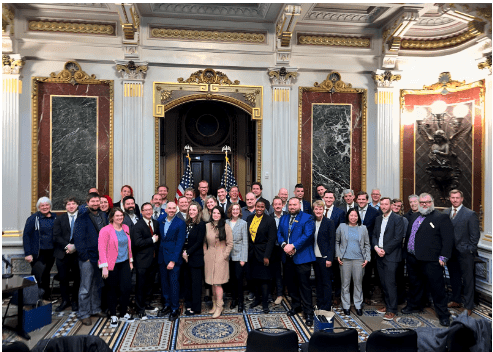 Hackers on the Hill contingent in Indian Treaty Room of the White House Campus There were Chatham House sessions with members of the ONCD, Clare Martorana (the Federal CISO), and Chris Inglis (the former director of the ONCD), a panel on “A Day in the Life at the EOP” with representatives from the ONCD, OMB, and the NSC, and an overview of the draft National Cyber Strategy. Overall, it was a great introduction to the Executive Office of the President (EOP) and the strategy itself, and it set the stage for the working groups. Bugcrowd was asked to join the working group that was working on coordinated vulnerability disclosure, which was one of the main parts of the strategy.
The National Cybersecurity Strategy document on which we provided input was released today. For Bugcrowd, the significance was squarely around the opportunity to participate and provide input on a document that is sure to set the expectations and tone for the relationship between builders and breakers – rebalancing the responsibility for cybersecurity, and elevating it from a niche domain to one that is truly approached as a team sport, including soliciting the input of the hacker and security research community itself.
Why It Matters
The focus of the strategy is rebalancing responsibility. From its inception, Bugcrowd’s vision has been to “level the cybersecurity playing field” by helping defenders engage the creativity of the good-faith hacker community to shift the resourcing and economic advantage away from the attacker. To defeat an army of adversaries, you need an army of allies, and the inclusion of Coordinated Vulnerability Disclosure in the National Cyber Strategy as well as the invitation to the hacker community to give input into its formation bode well for the future of crowdsourced security.
- Five projects will receive part of £5 million innovation fund to test new ways to reduce use of so-called recreational drugs
- On-the-ground projects include skills development and education for young people
- Supports strategy to reduce drug use to a 30-year low and build a world-class knowledge base
Five projects aimed at reducing drug use have been awarded £734,000 of the first allocation of a £5 million grant, with the remaining funding available across two further phases.
As part of the government’s Drug Strategy Innovation Fund, Phase 1 will see the successful applicants begin the initial stage of their projects offering a range of education-based programmes, skills development for young people and community outreach.
 Manchester Each project will receive initial funding to help develop interventions for evaluation. Those that are successful, and new projects, will be able to apply for further funding in Phase 2 which will launch later in the year to evaluate interventions over 12 months.
Projects for phase 1 are based in Huddersfield, Derbyshire, Manchester, Dorset and the South East of England and will include schemes tailored to meet local needs, including pop-up pods at festivals and events to educate people on the harms of using drugs – as well as workforce support to help young people develop personal and social skills to reduce vulnerability to illegal substance use.
Other projects include training programmes for night-time economy staff, such as people working in nightclubs, as well as experts from public health, voluntary services, the NHS and the police.
Health Minister Neil O’Brien said:
“Stopping drug use in its tracks is essential to protecting people and the community from the harms caused by addiction, which has devastating impacts and drives half of all crime.
“Projects like these will pave the way for new research into preventing drug addiction and enable us to meet our national strategy aim to cut drugs and crime.”
This is part of government plans to reduce the demand for drugs and will decrease the number of people requiring treatment as well as drive down the illegal and exploitative supply chain, anti-social behaviour and wider crime.
 The Department of Health and Social Care and the Joint Combating Drugs Unit – a cross governmental team based in the Home Office – have selected the National Institute for Health and Care Research (NIHR) to lead the research bidding process. The Department of Health and Social Care and the Joint Combating Drugs Unit – a cross governmental team based in the Home Office – have selected the National Institute for Health and Care Research (NIHR) to lead the research bidding process.
The selection process focused on encouraging creativity and innovation from applicants – looking at prevention of experimental drug use or early intervention as a way to prevent people going on to problematic or dependent use in the future.
Projects showing to be successful after evaluation and implementation in specific areas will be considered for national roll out across the country to stop drug taking in its early stages. The results of the studies will also be used to build a world class evidence base on how to tackle drug use.
Professor Lucy Chappell, Scientific Advisor for the Department of Health and Social Care, NIHR Chief Executive Officer, said:
“This is a really positive step towards expanding the evidence base on this important issue. I hope that the range of projects in this, and future phases, will identify effective interventions that can have a real impact across the country in the future. I look forward to seeing the outcomes of these projects.”
Projects were chosen following a competitive bidding process and passing an independent assessment committee made up of experts.
Successful projects
Zoë Welch, Head of Research, Change Grow Live said:
“Change Grow Live, in partnership with Middlesex University, are delighted to have the support of the NIHR Innovation Fund to Reduce Demand for Illicit Substances to prepare our Derbyshire 1625 Outreach Service for evaluation.
“1625 Outreach supports young people and young adults (aged 16-25) through place-based early interventions that improve knowledge and reduce demand and harm around substance use and associated risky behaviours.
“The innovative multi-strand approach works across rural and urban settings in Derbyshire and Derby city offering education programmes, responsive outreach, a branded van and pop-up pod at festivals/events, digital interventions, and night-time economy staff training.
“Our aim is to prepare 1625 Outreach for robust evaluation through literature review, stakeholder feedback, data linkage and creative methods to capture process and outcomes. We will use desk research, PPI, stakeholder consultation, and county-wide collaboration to refine the model and develop a framework to evaluate the different strands of outreach activity.”
Professor Michael Doyle, Professor in Mental Health Research, University of Huddersfield said:
“We are excited to start work on our project to reduce demand for illicit substances in young people through co-production, skills training and early intervention. As researchers at the University of Huddersfield, we are looking forward to working in partnership with young people and a multi-agency team of practitioners and experts from public health, voluntary services, the NHS, the police and education.
“We hope that getting input from all these stakeholders will help us develop learning resources that help young people build the skills they need, raise awareness and improve understanding to support positive lifestyle choices and reduce risky behaviours, including the use of illicit substances.”
Fiona Spargo-Mabbs, CEO, Daniel Spargo-Mabbs Foundation said:
“We’re very excited to have secured Phase 1 of this funding, to work with Middlesex University Drug and Alcohol Research Centre team led by Prof Betsy Thom, to develop and refine the DSM Foundation’s existing universal, multi-component drug education programme. Drug use often begins during adolescence, a period of life when attitudes and behaviours are emerging, and therefore have potential to be influenced before becoming established.
“There is evidence to show a multi-component approach to drug education can increase its effectiveness in preventing or delaying the onset of drug use in adolescence, but recent research is lacking, so we’re keen to establish what works, how and why.
“We’ll be engaging key stakeholders’ insights through surveys and focus groups, including young people and parents, as well as revisiting our current programme theory. By the end of this project we will have developed and refined our existing programme, and produced an evaluation strategy and methodology, ready for delivery and evaluation with young people aged 13–15 in a range of schools in Phase 2.”
Dr William Floodgate, Lecturer in Criminology, University of Manchester
“Our project will refine a new evidence-based, harm reduction-focused drugs education programme called The Staying Safe Programme (TSSP) so that it can be rolled out to universities across the UK. TSSP has been designed to reduce the demand for drugs among university students by equipping young adults with the knowledge required to reduce harms associated with recreational drug use, by deterring or delaying the onset of drug use, or by preventing the transition to heavy, or problematic use.
“We will use a range of methods to establish the appropriateness of TSSP, its in-built assessment of learning, and the effects of TSSP on the students who complete it.
The core research team consists of Dr William Floodgate, Professor Judith Aldridge, & Lydia Swan (University of Manchester), and at the University of South Wales, Professor Katy Holloway and Shannon Murray. Collaborators include: Professor Adam Winstock, Students for Sensible Drug Policy, and Universities UK.”
Claire Shiels, Corporate Director of Commissioning & Partnerships, Dorset Council
“The partnership in Dorset is absolutely delighted to be successful in this Phase 1 bid to test interventions that will help our workforce support young people to develop personal and social skills interventions that seek to reduce their vulnerability to illegal substance use and to develop effective communications with communities about the social impact of illegal substance use.
“Active collaboration between researchers, skilled practitioners, children, young people and parents and parents and carers are central to our programme and we believe this is an excellent opportunity to make a real difference. This work will be part of our local Combatting Drugs strategy and is an active collaboration between two local councils – Dorset and Bournemouth, Christchurch and Poole (BCP), the local health system and the police.”
 By Sascha Giese, SolarWinds Head Geek™ By Sascha Giese, SolarWinds Head Geek™
When it comes to digital transformation, one area of investment trumps all others. It’s not hardware. It’s not software. It’s not even the latest development in artificial intelligence (AI) and machine learning (ML).
It’s people. And if public sector organizations want to deliver data-rich government services, they need to recruit, train and retain IT professionals with the skills and personal qualities to make that happen.
Much of the discussion around digital transformation pivots around the latest solutions and how these have been employed to digitize cumbersome processes.
For instance, recently, HM Land Registry announced it is now ‘digital by default’, meaning that property-related applications can be submitted directly via its portal using its Digital Registration Service or by using legal software connected to its systems.
Elsewhere, Companies House — the government body that stores information on all the limited companies and limited liability partnerships registered in the UK — is introducing a new digital identity verification process to help combat fraud and money laundering.
People are pivotal to digital transformation
What links these two — and every other project that makes up the digital transformation journey — is that you need people to implement, manage and maintain these systems.
It’s true that to bridge the gap, the government often recruits expertise from external companies. But this can be costly. It’s also true that there is a global shortage of skilled IT professionals, which can make recruitment challenging. Despite these obstacles, if the public sector doesn’t invest in attracting new talent today, it’s simply a case of kicking this particular can down the road until the next time.
Which is why I was heartened to read recently about the work of the digital, data and technology (DDaT) function led by the Central Digital and Data Office (CDDO). Announcing the launch of its new Software Developer Graduate Scheme last autumn, those running the initiative explained why it’s so important.
“The scheme signals a step change in how we diversify the government’s graduate offer and directly addresses the shortfall in software developer talent,” the scheme’s leaders wrote in a blog.
“Our DDaT Workforce Insights Report published July 2022 reports 3,683 Software Developer vacancies across government. While we are starting small, this is direct progress towards addressing these gaps and improving the diversity of government’s Software Developer community.”
Maintaining a keen focus on skills
As part of their training, the recruits will look at topics such as software development processes, user-centered design principles, programming, cyber security, prototyping, and accessibility.
As those organizing this new training initiative explained: “[This is] a glimpse into how early talent programs can help fill our crucial skills gaps across government in order for us to deliver truly outstanding digital services to citizens.”
Crucially, the onboarding of this new intake of IT professionals involved more than just “software development processes” and “user-centered design principles” ¬ — as important as they are. The new recruits will also learn about other work-related issues such as well-being, mental health, and nutrition to create a “unique and holistic approach to learning.”
After all, addressing these issues is important when it comes to maintaining a motivated and happy workforce. Jobs are no longer solely defined in terms of role, rank and reward. Or to put it another way, investing in new people isn’t just about offering the biggest salaries.
There’s more to investing in people than just money
Instead, you need the right infrastructure in place to support people throughout their careers. Employers who want to recruit and retain the best talent need to create an environment where people want to work, contribute and make a difference.
It goes without saying that once people are embedded within an organization, they need to feel valued and motivated — alongside opportunities for personal development and growth — so their work remains fulfilling.
One way that is being addressed within the UK government is via the Civil Service Data Challenge. It encourages public sector workers to come up with new ways that government can improve its use of data. This year, it attracted more than 120 ideas from people across a range of grades, roles, professions and organizations.
This year’s entrants have now been whittled down to four finalists following a grueling Dragon’s Den-style pitch in front of judges. The finalists include a project to use AI to refine the Digital Mail Service; a data dashboard to identify and tackle modern slavery; using online gaming technology to conduct policy experiments in virtual worlds; and a project that seeks to improve levels of compliance for child maintenance payments. The winner is due to be announced in March.
Above all, this event shows how the public sector can harness the challenges of digital transformation to motivate and inspire its people to make a real difference. Alongside other initiatives, there are clear signs that the public sector is redoubling its efforts to invest in people. And it shows that when it comes to technology, people matter.
 Multi award-winning fleet management expert, Rivus, has been awarded multiple maintenance and repair contracts for the Metropolitan Police Service (MPS) from 1 November 2023. Multi award-winning fleet management expert, Rivus, has been awarded multiple maintenance and repair contracts for the Metropolitan Police Service (MPS) from 1 November 2023.
Following a rigorous, multi-lot, competitive tender process, which began in February 2022, Rivus has been appointed to take care of the prestigious fleet for a period of up to 10 years.
With over 43,000 officers and staff, the Metropolitan Police Service is the UK’s largest police force. It has over 5,200 fleet assets on the roads in Greater London, travelling 52 million miles each year.
Metropolitan Police Service vehicles are under significantly more stress and strain than the average vehicle on the roads of London and require specialist fleet expertise to keep it capable, responsive, and safe. During the new partnership, Rivus will manage the fleet maintenance and repair of 3,700 Emergency Response, Support and General-Purpose vehicles.
Victoria Knight, Chief Executive Officer (Interim) at Rivus said: “This is a hugely significant new business win for our business and recognises the journey we have been on and the progress we have made over the last three years as Rivus.
We have earned a reputation in our industry as the experts in managing the UK’s most critical fleets, and there is no fleet more critical than the Met Police. This is an exciting new chapter for Rivus, as we continue to accelerate growth, drive innovation, and deliver a financially healthy business for the future, demonstrating that Rivus is the only fleet partner our customers ever need.”
After 20 years with the same supplier, the Metropolitan Police Service had ambitions to move from a single supplier to a multi-supplier model, with the services split across six service area requirements covering Service Maintenance and Repair (SMR), Accident Management, Vehicle Collection and Delivery, and a comprehensive service management IT platform.
Rivus made the strategic decision to tender for all six contracts, hoping to demonstrate the breadth, depth, choice, and flexibility of its award-winning fleet solutions. Following a thorough and demanding procurement and evaluation process, the Metropolitan Police Service were so impressed with the strength and quality of the Rivus service offering, it has awarded all six contract areas to them.
MPS and Rivus have now entered a joint delivery transition period with the current supplier, with Rivus service delivery and contract ownership commencing on 1st November 2023. Between now and then, Rivus will work with the current supplier and the Met Police fleet team to ensure a seamless operational transition that keeps the critical Metropolitan Police Service fleet moving throughout.
Further updates and communications will follow on the progress of the delivery transition activity.
For more information on Rivus complete fleet management solutions visit: www.rivusgroup.co.uk/.
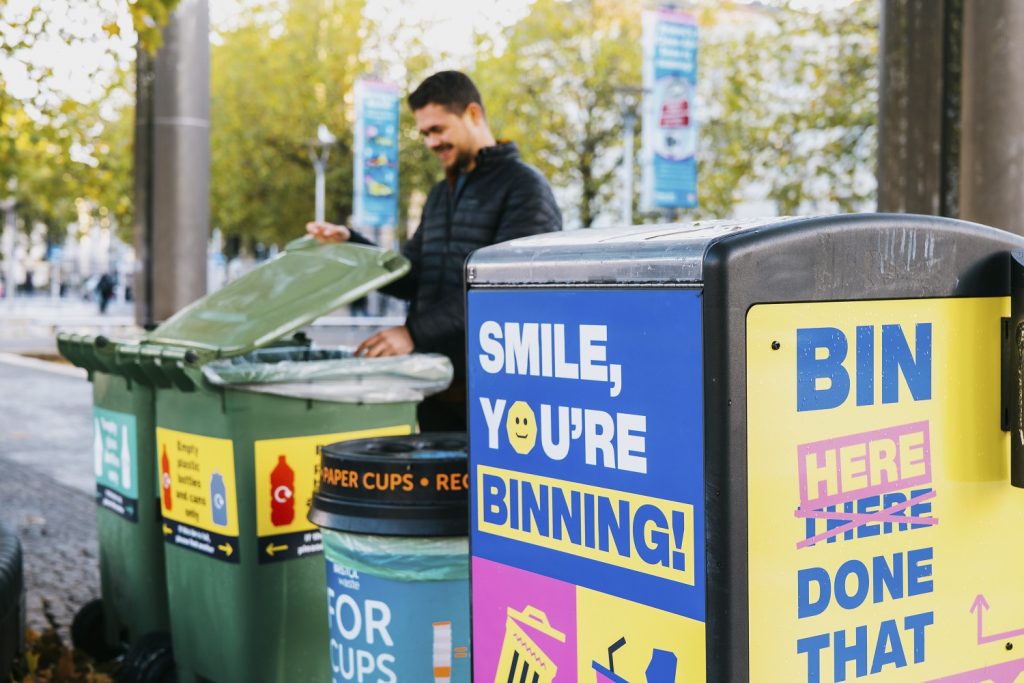 In The Loop Areas surrounding waterways in Bury, Derby, Adur & Worthing and Bristol will soon be adorned with colourful and eye-catching bins to help residents and visitors recycle when out and about. The news comes as environmental charity Hubbub and Coca-Cola announce the winners of the In The Loop grant fund that launched in October to roll out public recycling points and boost out of home recycling in four new areas.
The fund aims to help reduce litter and increase recycling by collecting more glass, plastic bottles and cans and put these items back in the loop to be recycled.
The new #InTheLoop trials will involve the roll out of bright, colourful and eye-catching bins, targeted messaging and local partnerships to encourage positive behaviour change, with a particular focus on reducing the level of rubbish reaching destinations downstream of the waterways where the campaigns are taking place.
The winning projects have been chosen as they offer the opportunity to test and learn from positive interventions in a range of different waterways, across various parts of the UK. They are:
- Bury Council, who will install bins in Burrs Country Park, particularly along the River Irwell. The trial will involve volunteers from Burrs Country Park to promote recycling and reduce litter.
- Derby City Council, who will situate bins along the River Derwent in the heart of the city and nearby green spaces including Darley Park and the River Gardens. This will be supported by local community groups such as the Midland Canoe Club and the Friends of Derby Riverside Gardens
- Adur & Worthing Councils, who will roll out bins along the seafront in Goring and Worthing, Shoreham Beach, Lancing Beach Green and Widewater Lagoon as well as work with community partners, the Coastal Office and West Sussex County Council to promote the improvements and monitor impact.
- Bristol City Council, with Bristol Waste Company, who will create a highly visible trail of on-the-go recycling bins that lead from Castle Park, along the water’s edge, through the heart of the city and around the Harbourside. The partners will work with local stakeholders to launch and promote the initiative.
 Along the River Derwent in the heart of the Derby City The four winning projects will launch this summer, following in the steps of other trials part of #InTheLoop, the UK’s biggest collaborative approach to boost recycling on-the-go, which was first trialled in Leeds in 2018, followed by similar trials in Swansea, Edinburgh, Dublin, Wimbledon, Telford and Lambeth. Combined, these projects saw over 2.5 million plastic and glass bottles and cans collected and recycled.
Learnings will contribute with renewed insight to the #InTheLoop toolkit, an in-depth guide on how to roll out successful campaigns, to benefit other interested local authorities and organisations who can access the learnings and downloadable assets for free.
Beau Zilesnick, Project Lead at Hubbub, said: “We were highly impressed with the quality of the winning applications. These projects were selected for their ambitious plans to improve recycling rates and reduce litter ending up in our waterways in a range of different settings across the UK from a city harbour in Bristol, to busy tourist destinations like Worthing Seafront and rivers running through popular parks in Derby and Bury. This will allow #InTheLoop to build upon its legacy of introducing effective recycling on-the-go in parks, towns and cities across the UK and Ireland.”
Aaron Patel, Head of Public Affairs at Coca-Cola GB said: “The Coca-Cola Foundation is delighted to be part of the programme to showcase those who are most committed to helping people recycle. We all want a cleaner environment and supporting local initiatives to help encourage recycling and improve recycling rates is one small step towards a more sustainable future. We believe that, by working together, we can make a real difference in tackling waste.”
For more information on In The Loop, and to view the toolkit, including downloadable assets, visit www.intheloop.org.uk.
 By Claire Harris – Head of regional business Vodafone UK By Claire Harris – Head of regional business Vodafone UK
When is your next bus due? How full are your local litter bins? How clean is the air where you live? How many parking spaces are available in this part of town right now? If a council can measure something, it can improve it with data-driven services. And those services can soon be faster, more accessible to the public, more efficient and better targeted thanks to the rollout of 5G technology across the country. The promise of fully digitalised local government, offering new and better services, delivered more efficiently, in ways tailored to the needs of residents, has never been closer.
There has undoubtedly been progress, not least because of changes to the way so many of us now expect to interact with businesses and public services. A large majority of resident contact received by councils now come through online and digital channels, although some of the residents whose needs are greatest are least able to access digital technology. Some councils are using tablets in the delivery of social care or installing smart monitoring around council and social housing. Others are using smart devices on streets and in neighbourhoods to provide key insights to improve residents’ services, such as waste management. But some local authorities are better placed than others to make the most of the digital future, with levels of take-up and implementation of digitalisation varying widely across the country. For example, only one in six are currently trying out predictive analysis techniques, such as using smart bins to improve the efficiency of waste collection routes or using sensors to manage parking spaces.
It’s easy to see why so many councils have not invested as much as they might have done in digitalisation. Local government has seen its funding from central government cut by an average of 50% over the last 12 years, and while some councils have taken this as a spur to digital innovation, not all have been in a position to invest in new technology: frontline services rightly have the first call on limited resources, even when longer-term investments can mean saving money in the future.
Lack of money is a barrier, but so is a disconnect between Whitehall and local government in terms of the incentives, organisation and guidance around digitalisation. Too often, there has been a tendency to design digitalisation guidance for central government and presume such guidance also applies to local council digitalisation. Too often, local government digital leaders are simply not involved in the development of new digital initiatives or applications.
That is why Vodafone is proposing the creation of a new layer of digital support at a regional level but above local councils: Regional Innovation and Technology Offices (RITOs), led by digital leaders with a successful track record in local government who could help to guide the rollout of full fibre and full 5G infrastructure.
But there’s no point pretending that money isn’t a critical part of the solution. And so, we are also proposing a new central pot, the Local Government Digitalisation Fund, to which councils could apply to carry out specific digital projects. Combined with 5G investment plans created by each council, and a central target for 5G local government rollout, this could go a long way towards closing the adoption gap between public and private sectors on 5G private networks and the wide variety of new opportunities they create. And encouraging pre-engagement between local government and commercial suppliers can help to ensure that services are properly focused on residents and their needs, not just on tech for tech’s sake.
Getting this right now won’t just help councils improve their services for residents. By helping them to predict and pre-empt problems, investing in digitalisation can create efficiency savings in the years ahead. At a time when all budgets are under pressure, thinking about the long term – about whether our councils are fully exploiting the potential of data, and about what we want local government to look like in the decades to come – is more important than ever.
 Oliver Gray, Charis business development director By Ollie Gray, business development director, Charis
So, are we better off or worse off this spring when it comes to our energy bills?
Unfortunately, despite falling wholesale costs, the average household bill is still set to rise to £3000 in April, and many will need to be tightening their belt just that little bit more again, particularly if we end up having a cold Easter! This is primarily because the EBSS and the government’s energy price cap are coming to an end, and as consumers, households will not benefit from the reduced wholesale prices until at least July.
With so much volatility in the market, it is imperative that the government works with the energy sector to try and instil some sense of stability. The worry and fear that households experience have as much of a devastating effect as the inability to pay their bills and are contributing to the overall state of the nation’s mental health, leading to an increase in rates of anxiety and depression.
For some time now, there has been an increasingly loud call for the introduction of a universal social tariff for the most vulnerable in our society. The desperation of many thousands of households unable to pay their bills has seen the scandalous increase in the number of prepayment meters being installed without any form of consultation with the householder, placing them automatically on the highest tariff and thereby worsening their overall situation.
While we agree with Martin Lewis that the price cap increase should be postponed (if not cancelled altogether), this must be done in line with a move towards establishing a social tariff. This universal social tariff will be a stable and consistent guarantee for those who are most vulnerable, removing much of the uncertainty and unpredictability for those who are more prone to the devastating mental health problems associated with poverty.
In 2022, Charis processed a total of £17.5 million in funding – nearly 70 per cent of this was on fuel vouchers – while this represents just a 10 per cent increase on the previous year, in the last few months, we have been selling a higher proportion of different kinds of vouchers as well. These figures are indicative of the growing sector of UK households who are falling into the poverty trap, whereas before, they would be living within their means. Until incomes start to balance out again against the cost of living, the reliance on government support funds is only going to get bigger.
Genomics England has completed installation of an enterprise imaging system that will help to support a world-pioneering initiative for cancer research. The programme is linking whole genome sequencing, pathology and radiology data, in what has been described as the world’s largest multimodal cancer research platform.
First announced in 2022 as a means to support new discoveries, Genomics England’s programme will help a wide range of researchers and scientists create a better understanding of cancer. It is hoped that this will lead to new treatments as well as supporting the development of cancer-targeting AI.
Genomics England has now deployed technology from medical imaging technology provider Sectra, that will play a central role in allowing the organisation to bring together underpinning data, so that researchers and developers from a wide variety of backgrounds can harness it in new ways.
In particular, the enterprise imaging system will allow Genomics England to incorporate NHS imaging data, whilst the Image Exchange Portal, a system used nationally in the NHS, will also allow it to transport images from participating NHS trusts.
This will mean diagnostic imaging data captured in the NHS, including radiology images such as x-rays, CT and MRI scans, and digital pathology images generated by NHS laboratories, can be linked with whole genome sequencing data from Genomics England.
To begin with 30 NHS trusts in England are providing data on solid tumours. This includes approximately 250,000 pathology images and 200,000 radiology scans, for 16,000 participants.
Once the radiology and pathology data in the system is matched with the genomics data, multi-modal data will be used by researchers to investigate and identify markers for cancer diagnostics and treatments.
Information will be kept highly secure with patient identifiable data removed for researchers outside of Genomics England, who will only have access to a Genomics England ID number, the age of the participant, and the name of the NHS site at which data was captured.
Dr Prabhu Arumugam, director of clinical data and imaging, and Caldicott Guardian for Genomics England, said: “This programme will push the boundaries of cancer research and how we work. It has the potential to transform clinical trials, change who can do research and development, and lead to the creation of new targeted treatments for cancer patients. The potential is vast.
“We will be able to understand mutations and when things go wrong in DNA, and importantly, whether that transpires into what clinicians see in medical imaging. We can also expose data in new ways to AI. All of that can help to facilitate new drug discoveries, and better inform which patients might benefit from particular treatments.
“Innovative working with Sectra is an important part of our initiative. The imaging system is already a very recognisable interface in NHS clinical settings, but we are using it in new ways. It will help us to harness imaging that we can then match to our genomic data, whilst de-identifying data to ensure confidentiality. The resulting multi-modal dataset will enable important research, break down traditional barriers, and support a safe and secure but accessible cloud-based research environment, that means many more people than bioinformaticians can harness genomic, pathology and radiology data.”
Deployed in the Genomics England’s cloud environment, the new research platform will be easily accessible for users, through a secure, fast and reliable interface.
Cloud deployment will also provide the flexibility to scale the initiative as more users come on board, and as the programme potentially expands to support research for non-cancers in the future.
Sectra’s enterprise imaging system is widely used in the NHS, where it supports healthcare professionals in diagnosing patient illness. The system installation was completed in February 2023, after a contract was awarded earlier in 2022.
Jane Rendall, UK and Ireland managing director for Sectra, said: “This is an inspirational initiative, that could help to change our understanding of cancers and other illnesses. We have been working with the NHS for decades in delivering digital maturity to diagnostic environments including radiology and pathology. This project makes greater use of that work, with exciting possibilities for research that could be immense. I eagerly look forward to seeing research emerge, and from that the potential for life-changing and life-saving treatments for patients.”
Electric vehicle (EV) infrastructure provider, SWARCO Smart Charging, and Connected Energy, a leading supplier of second life battery energy storage systems (BESS), have teamed up to help accelerate the roll out of EV charging across the UK and offer a decarbonised solution.
This collaboration aims to overcome two of the biggest barriers to the wider take-up of EVs among organisations wanting to provide EV charging for their own EV fleet or to provide public or private charging: energy capacity, and the costly and lengthy DNO upgrades that this can entail.
By working with Connected Energy, SWARCO Smart Charging will be able to provide a seamless integration of their extensive portfolio of EV charging hardware with Connected Energy’s E-STOR system, which is made entirely from second life electric vehicle batteries to provide onsite energy storage.
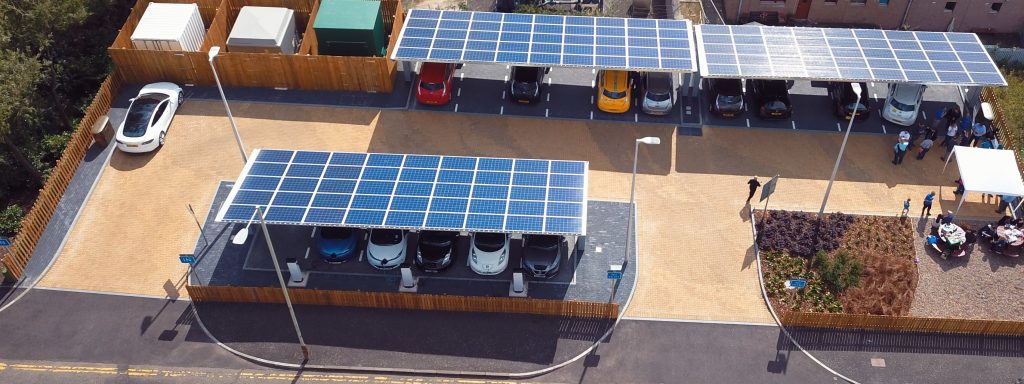 What’s more, E-STOR can be linked to renewable energy technologies such as photovoltaic panels allowing charging points to be powered by renewable energy – with excess power generated from the renewable sources stored until it is needed. The 24, second-life EV batteries used within each E-STOR come from Renault Kangoos. What’s more, E-STOR can be linked to renewable energy technologies such as photovoltaic panels allowing charging points to be powered by renewable energy – with excess power generated from the renewable sources stored until it is needed. The 24, second-life EV batteries used within each E-STOR come from Renault Kangoos.
Bringing battery storage and EV charging solutions together is especially important at large fleet depots or public charging hubs, where capacity is an issue. By drawing energy – either from the grid or from renewables – and storing it, energy is available to meet spikes in demand during busy charging periods, ensuring that drivers get the amount of power they expect when they plug in. For locations where a site simply does not have the power required to meet demand, active charger management can be provided to avoid peak load spikes.
Matthew Lumsden, CEO, Connected Energy says this collaboration between leading technology providers will bring ultimate flexibility and control to organisations that are committed to making a difference: “This is a natural collaboration between two like-minded companies that are both on a mission to support vehicle electrification and help to decarbonise charging for organisations and drivers.
“Our energy storage solutions, using second life EV batteries, seamlessly works together with renewable technologies and EV charging technologies to give charge point owners ultimate flexibility over the energy required to deliver EV charging,” Matthew explains.
This collaboration could not come at a better time says SWARCO Smart Charging’s Managing Director Justin Meyer: “Since we helped pioneer the installation of charging points in the UK more than a decade ago, as the size and scale of projects increases, we have seen EV charging projects hampered by the lack of electricity capacity. It is a constant issue, and one that until now has been difficult to overcome, resulting in EV charging roll out being scaled back, relocated away from preferred sites, or delayed.
“In many cases energy storage – integrated with renewable technology – is an excellent solution. And this is especially true when we are working with charge point owners who want decarbonised charging – a request that we have been seeing much more frequently already but the ongoing energy crisis is likely to make it an essential part of many more new EV charging projects,” he adds. “We are proud of the EV charging projects we’ve already delivered that use Connected Energy’s solutions and very much look forward to more successful projects in the future, including our extended range of high powered DC chargers.”
The two companies first started working together in 2017 when Connected Energy’s E-STOR system was installed alongside SWARCO’s charging technology at the UK’s very first charging hub in Dundee’s city centre. The battery system was installed alongside 22kW and 50kW rapid chargers linked to a PV array on the hub’s canopy to harness the power of the sun. The system monitors grid load to ensure power demand is always met and if charging from vehicles gets close to exceeding the power available from the grid, the E-STOR bridges the gap.
At present Connected Energy’s E-STOR unit delivers energy at a rate of up to 300kW and can, for example, simultaneously charge 20 cars for two hours at a rate of 7kW, or it can power two 50kW rapid chargers for almost four hours.
 Goupil G4 Cage Tipper A new Goupil G4 cage tipper from electric vehicle specialist Bradshaw has helped improve the working lives of Dunstable Town Council’s rangers.
The vehicle was acquired through Grounds Operations Manager Dmitriz Sopiaz who had been aware of its benefits through a previous role.
“I’d had experience of the G4, albeit it not with the tipper, and I knew it was reliable and did a good job.”
Available as pick-ups, vans and waste collectors, the Goupil G4 is designed to provide total versatility. With an operational range of up to 68 miles and a maximum speed of 31mph the G4 is purposefully designed with a variety of body types and features a safe and secure cabin with both left and right hand drive options.
Dimitrisz said his rangers find the vehicle ideal for transporting their tools, picking up litter and towing their pressure washer. Also its cage and tipper makes for ideal transportation and disposal of green waste.
He said: “Before I ordered the vehicle it had gone out to tender as required by our council’s procurement policy. I had liaised with the town ranger service to see if there was potentially any other model that might serve them better.
“We looked at the catalogue and the G4 was ideal. It suited all our requirements without us having to make modifications and it gave us the best value for money.”
Dimitrisz said with much of the rangers’ service being carried out in the town centre, it was imperative the new vehicle suited the council’s green policy.
He said: “This vehicle is quiet, it’s narrow which is ideal for when we are working on pathways, there are zero emissions which of course is hugely important in pedestrianised areas. It just ticked all our boxes.
“Further, the town rangers service is very well regarded and this vehicle was ideal as it’s compact, it looks the part and we have branded it with our logo which is great as the rangers are very often stopped by members of the public and being such a familiar sight in the heart of Dunstable, the branding helps make them more approachable.
“So far, so good, I’d have to say!”
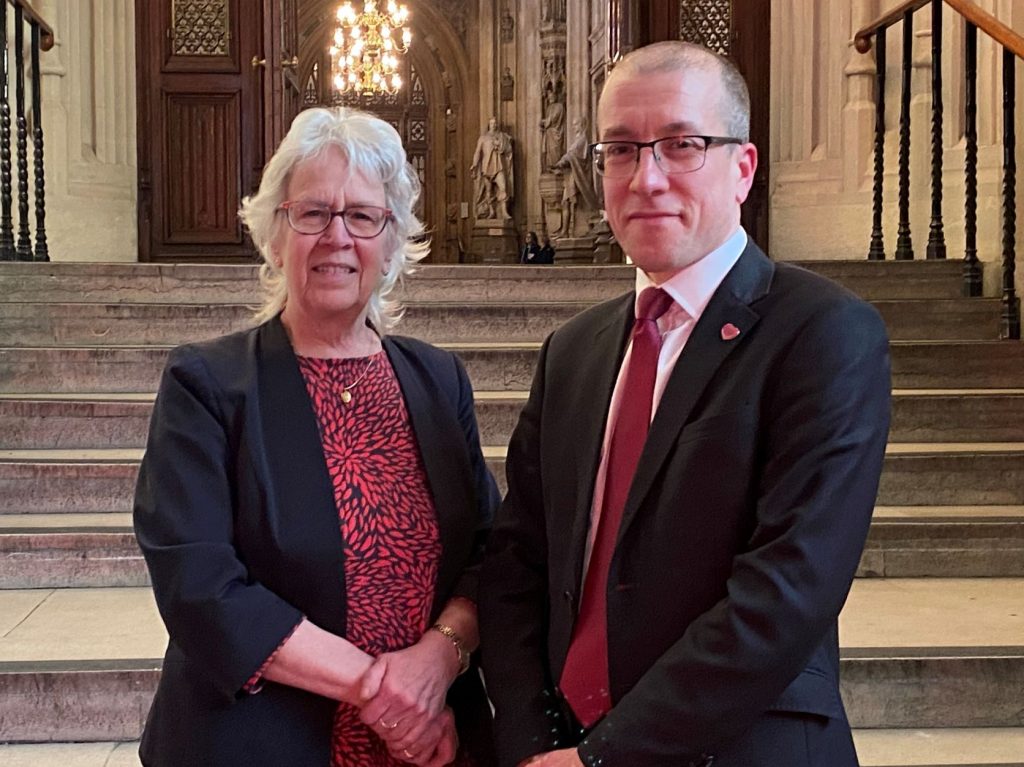 Baroness Blake and Tom Stannard Judith Blake, the Baroness Blake of Leeds CBE, has been appointed as the new Patron of the Institute for Economic Development (IED). She takes up the unpaid role from outgoing Patron, The Rt Hon Greg Clark MP, who was in post for two years.
A British Labour politician serving as a life peer in the House of Lords since 2021, Baroness Blake sits on the opposition front bench as a Shadow Spokesperson for Business and Energy. She was previously Leader of Leeds City Council from 2015 to 2021, becoming the first woman to hold the position, having been Deputy Leader for five years. An elected member of the Council since 1996, Baroness Blake also formerly served as an Otley town councillor.
Judith was awarded a CBE in the 2017 Queen’s Birthday Honours, and, in December 2020, it was announced that she would be conferred a Life Peerage after a nomination by Labour Party Leader Sir Keir Starmer. Currently Baroness Blake is part of the Liverpool Strategic Futures Advisory Panel, established last summer by The Rt Hon Greg Clark MP in his capacity as Levelling Up Secretary, alongside Liverpool City Region Metro Mayor Steve Rotheram (Chair) and Sir Howard Bernstein, former Chief Executive of Manchester City Council from 1999 to 2017, and another past Chair of the IED.
“I was delighted to be approached by the Institute of Economic Development to become its new Patron, and to formally accept the opportunity,” said Baroness Blake. “This is an important time for economic development and regeneration, and for the Institute and its members as the organisation embarks on its 40th anniversary year, and I am looking forward to supporting Chair Tom Stannard, Executive Director Nigel Wilcock, and other Board members in its mission and strategic priorities. In particular, I have a keen interest in keeping in touch with practice in economic development.”
IED Chair Tom Stannard added: “We are proud and privileged to welcome Baroness Blake as our new Patron. The Patron of the IED is an important national role, filled by someone who, due to his/her public achievement, exemplification of outstanding leadership and stature in society, can help the IED achieve its mission by enhancing the Institute’s credibility. My Board colleagues and I felt that Baroness Blake fits that profile perfectly, and we look forward to working with her over the coming years. I would also like to thank The Rt Hon Greg Clark MP for his service over the past two years, and we are grateful for his continued support in investing time in our 40th anniversary activities.”
 Mark Inskip – CEO, Matrix Workforce technology and services platform Matrix has officially become carbon neutral, having offset its carbon footprint by investing in a program that also addresses poverty by creating jobs, aligning with its goal of connecting people to work.
The update came as part of Matrix’s Annual ESG Report, which outlines key activities that took place in 2022 across all of its environmental, social & governance (ESG) workstreams.
In addition to offsetting the company’s carbon footprint, driven by an investment in Weyerhaeuser Uruguay, Forest Plantations on degraded Grasslands Under Extensive Grazing, Matrix has reaffirmed its commitment to a carbon reduction plan to reach net zero by 2040 – which includes a move to consolidate its data centre and migrate to Microsoft Azure, who are more aligned to environmental aspects of cloud computing.
Green initiatives have also been included in Matrix’s Social Value work. Throughout 2022, the firm has also adopted improved inclusive hiring processes that value people and diversity, progressing from level 1 to level 2 on the disability confidence scheme, and signing the Armed Forces Covenant to ensure fair treatment of those who have served.
“Matrix is committed to implementing sustainable and responsible business practices that align with our ESG principles alongside our purpose of connecting people to work,” says Mark Inskip, CEO, Matrix. “We recognise the importance of protecting the environment and promoting social and economic development within both our local and national communities. By aligning our ESG aspirations to our business purpose, we can not only improve our bottom line, but also contribute to building a more sustainable future for all.”
In line with its mission to do business responsibly, Matrix has also signed up to the Slave Free Alliance and the Real Living Wage Foundation to ensure all staff receive a wage that meets every day needs, continuously reviewing and improving all processes and policies.
Looking ahead to what’s to come in 2023, Matrix will continue to invest social programmes that value its people and diversity, including supporting individual growth, continue to work towards its goal of net zero by 2040 by consolidating its data centre, and work to improve the community through a charity partnership with Refugee Action.
“We are delighted with the progress we have made on our ESG aspirations and we want to push this even further in 2023,” said Inskip. “Our next step to ensure we are a responsible business is to make sure this is reflected across the supply chain we engage with, supporting our suppliers by offerings guidance and training on key themes including diversity, equity and inclusion.”
- Ashford and St Peter’s Hospitals NHS Foundation Trust is the first in the UK to install solar e-bike charging stations at its two hospital sites.
- Solarcycle is the first company to offer an off-grid, solar ‘in a box’ EV charging solution designed to provide green, renewable energy for the charging of e-bikes and e-scooters.
- Ashford and St Peter’s already have the highest number of EV charge points of all NHS Trusts in the UK.
- With it being solar, there is no need for a mains connection, no ongoing energy costs, and all staff can benefit from free-to-use recharging of their e-bikes.
- If used to replace car travel, e-bikes have the potential to cut car CO2 emissions in England by up to 50% – about 30 million tonnes per year.
Ashford and St Peter’s Hospitals NHS Foundation Trust (ASPH) (www.ashfordstpeters.nhs.uk) is the first in the UK to install Solarcycle’s (www.solarcycle.uk) off-grid solar e-bike charging stations at its two hospital sites. Solarcycle is the first company in the UK to offer an off-grid, solar ‘in a box’ EV charging solution designed to provide green, renewable energy for the charging of e-bikes and e-scooters. Ashford and St Peter’s installed the charging stations to support staff wellbeing, to reduce pressure on car parking, and to contribute to the Trust’s sustainability and NHS Net Zero efforts.
Solarcycle UK develops and installs scalable, low-cost e-bike and e-scooter solar charging stations to help organisations achieve their sustainability, transport, and employee well-being goals. For Ashford and St Peter’s, the important factors in installing Solarcycle’s charge points are the low-cost, quick impact and minimum disruption the solution offers. There is no disruptive trenchwork required, which can save up to 60% of the cost of installing an EV charger. Plus, it being solar, there is no need for a mains connection, no ongoing energy costs, and all staff can benefit from free-to-use recharging of their e-bikes.
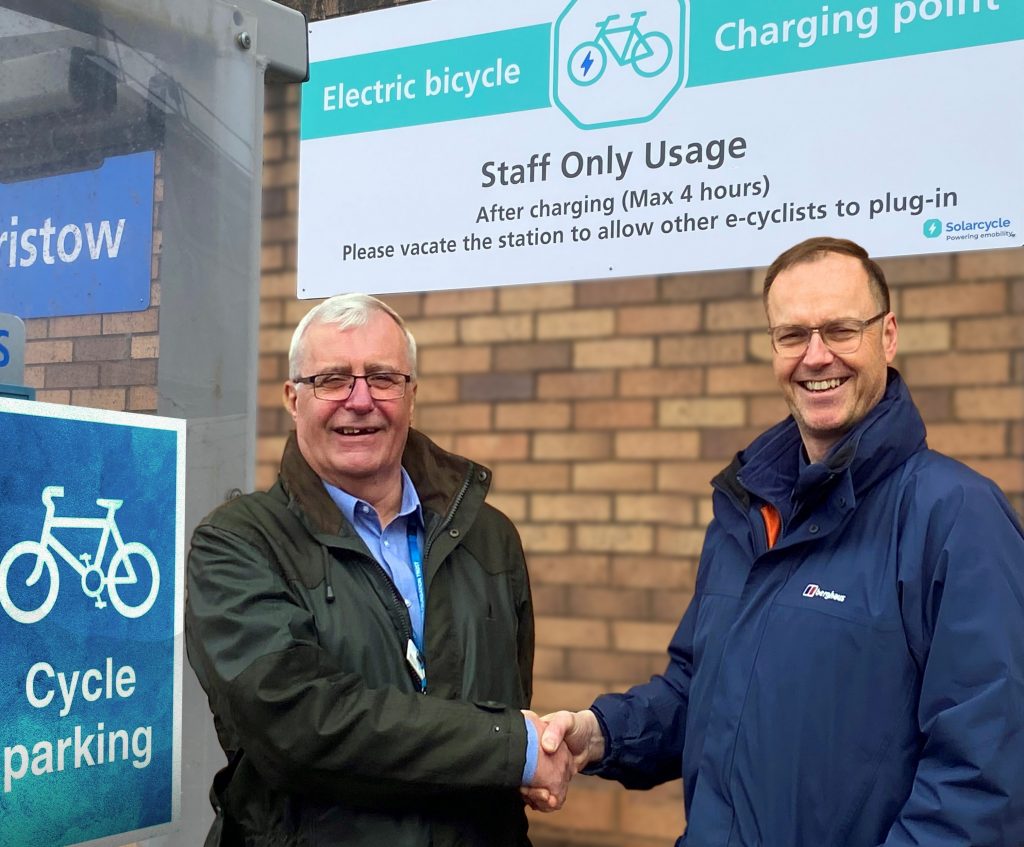 Andy Hyatt – Facilities Support Services Manager at ASPH & Paul Stratford, Founder of Solarcycle UK Andy Hyatt, Facilities Support Services Manager at ASPH said “We are the only Trust in the country with solar powered e-bike points. We have installed many e-car chargers at our sites so it’s great to now have some cycle ones.”
“Getting about by e-bike is a great way to get out of the car and avoid the traffic and parking charges.” Tom Smerdon, Director of Strategy and Sustainability at ASPH said, “It’s very exciting to see the e-bike charging points being installed here at the Trust, helping us reduce our carbon impact, improve our wellbeing and support local enterprise and innovation.”
“I am thrilled for the first installations of Solarcycle’s e-bike charging stations to be at ASPH Trust’s two hospital sites, thanks to Andy Hyatt’s and Tom Smerdon’s foresight.” said Paul Stratford, Founder of Solarcycle UK. “The Trust is a pioneer and shining example in EV-charging, so Solarcycle is a natural addition to this effort with our seamless solution that brings immediate benefits with future scalability. The credibility of being an NHS approved supplier means other NHS Trusts and organisations can follow suit in the knowledge that our solar-powered e-bike charging stations will positively contribute to their sustainability priorities, their staff well-being, and supporting people in navigating the cost-of living crisis by encouraging them to switch from commuting by car to an e-bike.”
 Ashford Solarcycle’s e-bike charging stations were installed in line with Ashford and St Peter’s staff wellbeing initiatives and sustainability priorities to reduce carbon emissions. The Trust have two ‘Cycle to Work’ schemes that offer staff the benefits of tax-free bikes and accessories for their commute to work, including road, mountain, hybrid, and electric bikes. Ashford and St Peter’s already have the highest number of EV charge points of all NHS Trusts in the UK and they are now the first in the country to have an e-bike charger, powered from renewable solar energy.
Solarcycle’s chargers are accessible to all e-bike users, featuring UK standard universal 3-pin sockets. The system captures sunlight via flexible PV panels and converts this renewable energy into electrical current for e-bike and e-scooter charging via lockable IP-66 rated sockets on the SolarPoint pillars. Each pillar is configured to charge up to two bikes simultaneously, enabling the average e-bike and e-scooter to commute 20 miles a day for most of the year. Solarcycle is designed to help power the switch to clean electric transport with the easiest, quick impact and cost-effective off-grid solar charging points for e-bikes and e-scooters.
The demand for e-bikes has soared during lockdown, and a recent study by CREDS researchers at the University of Leeds found if used to replace car travel, e-bikes have the potential to cut car carbon dioxide (CO2) emissions in England by up to 50% – about 30 million tonnes per year. The cost-of-living crisis is also encouraging more people to give up their cars and switch to electric bikes. Solarcycle is designed to meet this growing demand and to help power the switch to clean electric transport with the easiest, quick impact and cost-effective off-grid solar charging points for e-bikes and e-scooters. (www.solarcycle.uk)
CHANNEL 3 CONSULTING has recruited Leo Jones, a former deputy director of children’s services, as a partner to support the company’s continued growth and further strengthen its position in the social care sector.
A qualified social worker and children’s services manager with over 20 years’ experience across consulting and the public sector, Jones will also be Channel 3’s head of delivery.
Immediately before joining Channel 3 Consulting, he was a director at management consultancy IMPOWER. While there, he led a range of complex and innovative whole-system transformation programmes across health and care, with a particular focus in the special educational needs (SEND) and learning disabilities sphere.
His work in this space focused on driving earlier support for children with SEND, through the use of innovative digital assessment tools, and placed a greater focus on improving longer-term outcomes and supporting independence into adulthood.
 Leo Jones – Channel 3 Consulting As a result of his work he was named the 2021 ‘Thought Leader Consultant of the Year’ at the Management Consultancies Association Awards and was asked to present to the director general of the Department for Education and her team.
A passionate advocate of technology’s ability to deliver insights that can help change behaviours, Jones is known for his focus on evidencing the tangible human impact of digitalisation.
Commenting on his appointment, Jones said:
“Channel 3’s reputation for helping organisations harness the power of technology to transform services for the benefit of citizens and patients continues to grow.
“I am thrilled to join a team that is so clearly passionate about what it does.
“With the health and care sectors at breaking point, the need for digital intervention is greater than ever before. Technology can of course drive efficiencies but perhaps more crucially, it can dramatically improve the day-to-day lives of those who deliver and receive vital services.”
John Howard, CEO of Channel 3 Consulting, added:
“Leo has led some of the UK’s most forward-looking work on improving social care and healthcare services. He shares Channel 3’s purpose of harnessing the potential of technology to improve lives and deliver better care, and is committed to helping our clients achieve tangible results for the people they serve.
“His personal experience as a social worker gives him invaluable insight into what service users need, the role technology can play in making services better and how to work effectively with frontline staff to make change happen in a positive way.
“Having Leo in our team will give Channel 3 even more opportunities to help clients overcome the pressures that increasing demand, workforce shortages and tight budgets continue placing on the health and care sector.”
In the past 12 months, Channel 3 Consulting has been awarded several digital transformation contracts in the UK and overseas.
Recent clients have included Reading Council, NHS England, Central and North West London NHS Foundation Trust, University Hospitals Coventry and Warwickshire, the Ministry of Defence, Greater Manchester ICS and Bermuda Hospitals Board.
These notable client relationships have helped deliver over 40% growth at the company since it underwent a management buyout in 2021.
 Chubb’s senior leaders (from left to right) David Dunnagan, Gary Moffatt, and Terry Sallas Chubb, one of the UK’s leading fire safety and security solutions provider, has strengthened its senior leadership team with a number of significant appointments.
Following the recent senior executive hires and promotions for Chubb Group globally, the UK and Ireland team welcomes three new leaders. David Dunnagan was promoted to Managing Director of Chubb UK&I, following Brendan McNulty’s promotion to the newly created role of Vice President – Europe last summer. David has enjoyed a successful career with Chubb, starting as an apprentice in 1993. He now drives the company’s ambition of becoming the employer of choice and the number one fire and security business in the UK and Ireland.
Gary Moffatt has been promoted to Director for Fire and Security UK. Continuing his long and successful career with Chubb, Gary’s appointment is his latest milestone achievement, having secured several promotions since joining the organisation in 2001 as a university graduate.
A new addition to the Chubb senior leadership team is Terry Sallas. Terry joins as Managing Director of Major Projects and has a proven track record of helping organisations create a vision, discover new markets, and grow. He will lead projects incorporating specialist solutions through its technology-leading businesses, Chubb Systems, Frontline Security Solutions, Fire Systems, and the software brands, Sisys and Mentor.
David Dunnagan told GPSJ about the new appointments: “I am delighted that we have significantly strengthened our senior leadership team. Gary and Terry bring an incredible amount of knowledge and experience to our team, and together with the wider team, we will lead Chubb into its next ambitious growth phase.
“We’re guiding our customers through the digital switchover and harnessing the power of new technology, so our fire and security solutions are even better connected and help customers lower their impact on their operations. By getting the basics right, we can be even more responsive and tailor our offering to provide a personal service to our customers. From there, we can evolve and be the number one provider for fire protection, life safety, and security.”
The Chubb senior leadership team is made up of great leaders who each has decades of industry experience. From the core pillars of the business through to business functions such as Digital Technology, Communications & Marketing and Employee Experience & Development, these individuals are the driving force behind the organisation’s success.
 Mark Venables (left) and Dr Alastair Kirby Dr Alastair Kirby, Industry and Technology Navigator at Kent Surrey Sussex Academic Health Science Network (KSS AHSN) reflects on why effective marketing is crucial to the success of new products and how innovators can kick start their marketing activities.
Why am I not being noticed?
You’ve got an innovative and excellent product, so why aren’t NHS influencers and decision makers talking about it? Simple answer may be that they don’t know about you, your product or its value. Effective marketing can help you to change this.
As part of this blog, Mark Venables, CEO and one of the founders of specialist agency Highland Marketing, helps me to explore the challenges health-tech/med-tech start-ups and new product teams face.
Marketing is about translation
Mark helpfully summarises marketing as “being able to explain your product quickly to help understand its relevance and how it meets needs.”
I see marketing as translation. A lot of start-ups and new product teams focus on product development, but they don’t think enough about what the impact of their product is for potential users.
Med-tech and health-tech innovators are often clinicians or technologists with passion and a brilliant idea rather than entrepreneurs. Their skills are in technical areas, not necessarily in explaining benefits to influencers and potential purchasers. However, they need to translate their product features into benefits, then get the message out to their customers.
The challenge is converting ideas into value. You can convert ideas into value by investing in a thought-through marketing, public relations, and sales strategy. In the early stages of an idea, this investment could be time but, as your product scales up, your strategy will need allocated funding.
Articulate your value
Mark shares an anecdote about a start-up sharing an investment deck with him. He showed it to some contacts, but no one saw much value in it. However, when one of those contacts met the start-up managing director and got talking about the product,
what he heard bore no resemblance to the deck, but was of very real interest.
So, a business idea well worth consideration, but the document intended to drive investment just didn’t translate its value. Bottom line, you can’t expect a potential investor or customer to work out what’s good about your innovation, it’s up to you to identify and articulate the value proposition of your product.
Cut through with a clear message
You can articulate your value by cutting above the noise, with a message that’s crisp, clear, relevant, and segmented on your customers. Case studies and stories are a great way of showing impact on clinicians’ lives and on patients’ outcomes.
There’s a real benefit in bringing in a specialist too, an organisation or a consultant that understands communication, knows how to workshop your messages and stories, and understands the health and care context. As Mark, says you’re dealing with a sophisticated audience who want to get to the facts quickly and to know they can trust your knowledge and understanding.
Invest for success
Innovators often ask the KSS AHSN Industry team where they should invest time and money on promotion and relationship building. Mapping this journey is different for each innovator, but there is a common theme – clearly articulating your value to the NHS is vital for success.
Some innovators view marketing costs and time as something to be minimised, given they take resources away from R&D and headcount budgets. Innovators need marketing as much as they need product development or senior team members. It’s fundamental to getting your message and impact across to an expert audience.
Mark’s view is that 20-30% of revenue to get you established, then diminishing over time. It’s a difficult call though, especially at the early stage when there’s no meaningful revenue. However, if marketing spend isn’t regularly on your list of major budget items, or on your investment deck, you’re probably not spending enough.
Marketing as a forethought
Marketing as an afterthought is a major problem. This is when an innovator waits until they have understood a need, worked on the technology and developed a product before thinking about how to talk to people about the product.
My advice is to include marketing from the get-go. Marketing is as much about listening to your customers as is it talking to them. Seek feedback, thoughts, and advice on your idea at an early stage.
This doesn’t have to mean a five-figure budget. You also need some headspace to focus on commercial matters. Ideally, you’ll have a senior development team colleague reflecting customer needs, crafting the value proposition, and setting the strategy and plan.
Work with a partner
Mark’s biggest piece of advice for start-ups and scale-ups is “don’t underestimate the importance of working with a partner that has an understanding of the market space.”
I entirely agree. Whether you’re focused on a new product, or running a lean start-up, chances are you’ll benefit from both an external perspective and expert input. Both of our organisations – KSS AHSN and Highland Marketing – are in that business. We can help you get started with clearly articulating your value.
Get in touch with our team at KSS AHSN to find out how we can help. Highland Marketing are available to advise via the following link.
Environmental charity Hubbub and McDonald’s have launched a new #InTheLoop grant fund to help local authorities and other interested organisations boost out-of-home recycling in public spaces.
The #InTheLoop fund will support two new projects to introduce or improve their recycling infrastructure using the #InTheLoop toolkit. This in-depth guide on how to roll out a successful recycling on-the-go campaign aims to help increase recycling rates and reduce the amount of waste sent to landfill or incineration.
The new funding has been provided by McDonald’s and will grant the two successful applicants £8,000 each to invest in, and boost, anti-litter and recycling facilities. As well as the funding, Hubbub will provide ongoing support based on the charity’s expertise and experience in delivering recycling campaigns. This includes support with project management and design to help bring their projects to reality and to support their delivery. 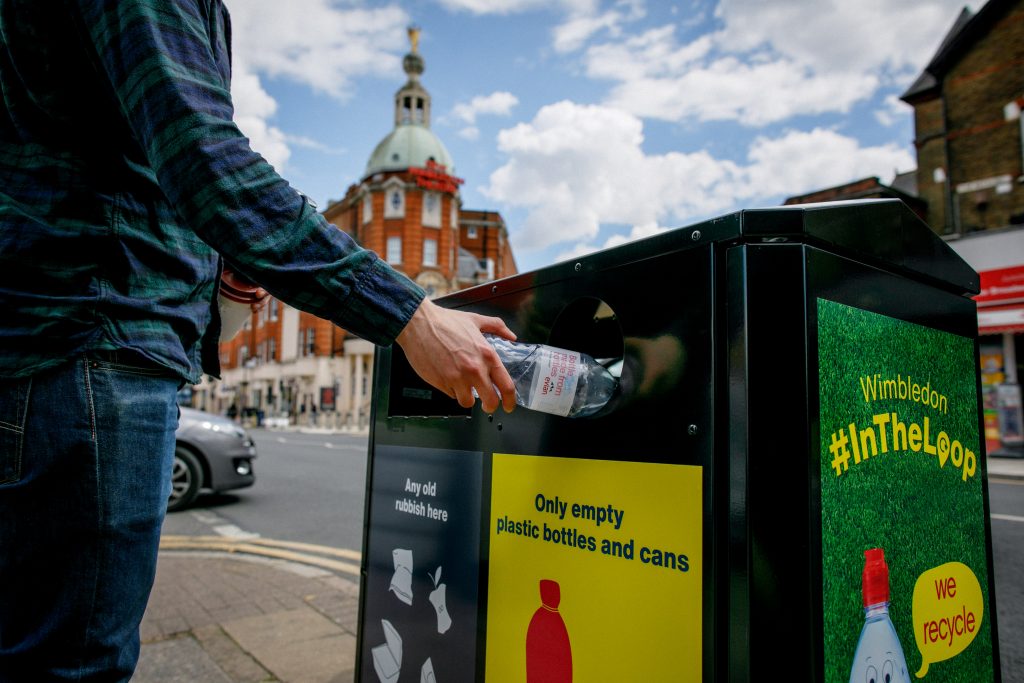
Organisations such as local authorities, business improvement districts, shopping centres, major property owners and transport hubs are invited to apply. The application deadline is 17 March 2023.
First trialled in Leeds in 2018, with support from McDonald’s and other businesses, #InTheLoop is the UK’s biggest collaborative approach to boost recycling on-the-go. Subsequently, Swansea, Edinburgh, Dublin, Wimbledon, Telford & Wrekin and Lambeth have all run similar pilots, installing and testing a range of bright, colourful and eye-catching bins to make it as easy as possible for people to recycle empty glass, plastic bottles, cans, and in some cases coffee cups, and therefore improve recycling rates. Across all these #IntheLoop pilot projects, over 500 bins have been rolled out and over 2.5 million plastic and glass bottles and cans were collected and recycled.
The #InTheLoop toolkit, which was funded by environmental compliance scheme Ecosurety, brings together key learnings and insights gathered from these trials and aims to act as a blueprint for the winning projects.
Gavin Ellis, co-founder of Hubbub, said: “Recycling on the go continues to be a significant challenge, with less than half of local authorities currently having on-street recycling systems. Previous #InTheLoop trials have helped us define an effective approach to out of home recycling, so we’re delighted that additional funding from McDonald’s will enable two more organisations to trial #InTheLoop interventions in their area to help address littering, boost recycling rates and reduce waste sent to landfill or incineration.”
Helen McFarlane, McDonald’s Senior Sustainability Consultant said: “We’re delighted to be funding this piece of work. McDonald’s has been working with Hubbub on their innovative #InTheLoop campaigns for over five years now, and we’re excited that this project builds on all the success we’ve had over the years. We hope that by providing funding to roll out #InTheLoop we can have a lasting impact in the communities we serve.”
For more information on the grant funding and to access the In The Loop toolkit, including downloadable assets, visit www.intheloop.org.uk or contact intheloop@hubbub.org.uk
 New research from environmental charity Keep Britain Tidy reveals a major barrier to driving urgently needed waste reduction and reuse behaviours is a fundamental misunderstanding amongst the public of what waste prevention actually means. New research from environmental charity Keep Britain Tidy reveals a major barrier to driving urgently needed waste reduction and reuse behaviours is a fundamental misunderstanding amongst the public of what waste prevention actually means.
Under the waste hierarchy (more commonly communicated to people as ‘reduce, reuse, recycle’), recycling is important, but reduce and reuse sit above this and are crucial when looking to lessen the environmental impact of what we purchase, use and dispose of. However, people feel they are “doing their bit” for the environment by recycling; while this should not be discouraged, the charity is calling on policy-makers and practitioners to work together to educate and motivate people to move beyond recycling and make choices that reduce the environmental impact of what they purchase in the first place.
In the absence of meaningful progress at government level on waste prevention or steps to bring down resource use, the charity has launched a new report for waste management and sustainable consumption policy-makers and behaviour change practitioners to ignite debate on waste prevention barriers and prompt urgent action.
Bringing together quantitative surveys, focus groups and an ethnographic study the report reveals key insights about the public’s waste prevention knowledge gaps and their attitudes to waste, including:
- Lack of understanding about the waste hierarchy
The prioritisation of recycling over waste prevention in policy has led to a fundamental lack of understanding of the waste hierarchy among most of the public. This is a significant waste prevention barrier that needs to be addressed as a priority especially as when the waste hierarchy is properly explained, the public easily understand the concept. In Keep Britain Tidy’s national survey, when presented with a visual representation and explanation of the waste hierarchy, 55% agreed that they now have a better understanding of how waste should be dealt with to minimise its environmental impact.
- People associate waste more with what they throw away than what they buy
A far greater proportion of people associate negative environmental impact with putting things in the bin (not recycling) compared to buying the things they want and need (83% compared to 49% respectively). Keep Britain Tidy recommends a shift in narrative to focus more on what we buy rather than what we throw away.
- Lack of knowledge between waste prevention and the climate emergency

Stronger links need to be made between the climate emergency and how waste prevention behaviours make a difference. The survey showed 68% of people think that recycling is the best thing they can do to reduce the environmental impact of the things they buy and a third (33%) said they didn’t realise there are much better ways to reduce the impact of their waste than recycling. Eight in ten people say, as a country, we buy too much stuff (79%) but only a quarter (25%) say they personally buy too much stuff. This demonstrates that the concerns people may have about consumption aren’t related to their own personal behaviour.
- More dialogue is needed about waste prevention
The research showed a lack of understanding of what waste prevention actually means, particularly the practical things people can do to prevent waste. People see waste as something to be ‘managed’ rather than prevented – ‘wasting better’ rather than ‘wasting less’. There is a clear need for more dialogue and celebration around people’s waste prevention behaviours and good practice. Using the insights from the report, Keep Britain Tidy launched Buy Nothing New Month at the start of January, a new behaviour change intervention to help people move up the waste hierarchy. Throughout the month, Keep Britain Tidy shared tips and tricks on how people could buy nothing new and make the most of what they already had. The campaign called on people to rethink what they wanted versus what they needed, reconsider if they could repair versus replace and think about whether they cold rent, borrow or buy second-hand rather than buy new. (See box out for more information).
- We need the right infrastructure in place to make it as easy as possible for the public to reduce and reuse
The research revealed that only four out of ten people (41%) feel they have access to products and services that can help them reduce waste. More investment, signposting and promotion of local initiatives from repair cafes to rental schemes is crucial to help drive change.
Allison Ogden-Newton OBE, Chief Executive of Keep Britain Tidy said: “We urgently need to see a widespread adoption of waste prevention behaviours to help bring natural resource use and carbon emissions down to environmentally sustainable levels. Moving people up the waste hierarchy, from recycling to waste prevention, is a huge challenge when our current systems are geared towards increased consumption of resources.
“While government waste prevention policies are continuously delayed, the onus is on practitioners to drive behaviour change. This includes NGOs working on all aspects of ‘reduce, reuse, recycle’ and sustainable consumption and also local authorities as people’s most prominent source of information about recycling. Collectively, we have to attempt to counteract the marketing messages that people are bombarded with, continually pushing them to buy more stuff.
“Learnings from our first Buy Nothing New Month campaign will help develop the evidence base around how to help people move up the waste hierarchy to buying less stuff and maximising the life of stuff that already exists. This is just the beginning and we invite other organisations to collaborate with us, debate and share evidence to take this agenda forward.”
The report, the research that underpins it and the Buy Nothing New Month campaign have been made possible thanks to an award from Postcode Earth Trust, a grant-giving Trust funded entirely by players of People’s Postcode Lottery.
 A New Behaviour Change Intervention – Buy Nothing New Month A New Behaviour Change Intervention – Buy Nothing New Month
Keep Britain Tidy’s research ultimately aimed to generate insights to inform a new behaviour change intervention to help people prevent waste and therefore consume more sustainably. As a result, in January 2023, the charity launched Buy Nothing New Month, a new behaviour change intervention and digital campaign that embraced buying nothing new for the whole of January, “to save your pennies and protect your planet”.
Throughout the month, Keep Britain Tidy shared tips and tricks on how people could buy nothing new and make the most of what they already had. The campaign called on people to rethink what they wanted versus what they needed, reconsider if they could repair versus replace and think about whether they cold rent, borrow or buy second-hand rather than buy new. (See box out for more information).
The campaign pillars:
- People were encouraged to buy nothing new to save money while protecting the environment. The charity also drew on the motivation to save space and reduce clutter.
- The charity emphasised the environmental harm caused by buying new stuff, in terms of the finite natural resources used and the carbon emissions created while also referencing the further environmental damage caused by our throwaway culture.
- Keep Britain Tidy celebrated the pride that can go along with buying nothing new and encouraged a culture of talking about this.
Ahead of the campaign, Keep Britain Tidy’s research found that 67% of people agreed that they were confident that they could buy less stuff and a further 49% agreed they would like information/support to help them reduce the environmental impact of the things they buy.
Buy Nothing New Month was ultimately designed to provide support and the social opportunity for people to move up the waste hierarchy, from recycling to waste prevention (reframed as ‘buying nothing new’) and reduce their environmental impact in a way that works for them.
The campaign is currently being evaluated and results will be published later in 2023.
Sodexo has been awarded a three-year contract with The Insolvency Service to provide strategic programme and advisory services to support the organisation’s ‘Transforming Workplaces Project’.
Partnering with Rider Levett Bucknall (RLB), global construction and property consultancy, Sodexo’s Property Professional Services business and RLB will support The Insolvency Service to rationalise and transform its existing estate and help deliver the five-year programme of major and minor fitouts, building closures and disposals.
Together they will deliver a range of services including:
- strategic and advisory services
- commercial and procurement advice and support (provided by RLB)
- project management (provided by RLB)
- space and design expertise
- support and advice on move management
- principal designer services (provided by RLB)
- assurance for projects and delivery
 Dan Weiss Dan Weiss, managing director of Sodexo’s Property Professional Services said: “We are delighted to be appointed as a strategic partner to The Insolvency Service to help rationalise and transform their estate. We look forward to working together with The Insolvency Service and RLB to bring to life their vision which is aligned to the Government Property Strategy for a smaller, better and greener estate.”
Sodexo’s services have been procured via the Crown Commercial Service Estate Management Framework (RM 6168) where Sodexo is a supplier on three lots:
Lot 1 – Total Estate Management
- Estate asset and property management
- Agency and lease management
Lot 4 – Surveying and Strategic Advice
- Technology based surveys, studies and strategy
- Procurement managed services
Lot 7 – Integrator
- Systems and helpdesk
- Performance and supplier management
The framework has recently been extended by a year expiring in July 2025.
 Sascha Giese Sascha Giese, SolarWinds Head Geek™
The recent spike in energy prices has once again drawn attention to the costs associated with powering IT infrastructure, and high-density technologies such as data centres aren’t the only things under the spotlight.
The energy consumption of technology across departments and agencies within the government—including PCs, laptops, and peripheral devices such as printers—is under the microscope as civil servants look to manage budgets and keep a lid on costs.
Though recent sharp increases in energy costs have focused the mind, the public sector is no stranger to taking action to make its technology estate more sustainable.
It’s a point etched in the Greening Government ICT Annual Report 2021 to 2022 published recently by the Department for Environment, Food, and Rural Affairs (Defra). Although Defra is better known for its work with farmers on matters such as rural affairs and food production, its increasingly important focus on environmental matters means it’s now the lead government department for sustainable information and communications technology (ICT) within the U.K. government.
Seeking energy efficiency across the government’s entire IT estate
As part of this ever-growing task, one of Defra’s roles is to ensure government ICT services are “designed, delivered, and operated with sustainable principles at their core.” This includes Defra’s Digital, Data, and Technology Services (DDTS) team, which is tasked with looking at the environmental impact of IT across the government to ensure sustainability is an integral part of the delivery of the government’s digital services.
This includes the procurement of technology and services to ensure they’re as energy efficient as possible—both within the government’s own IT estate and the companies providing services with systems held elsewhere.
“The ICT estate on government property has become more energy efficient as departments have moved into service provisions driven by Cloud First and Digital Policies,” says Defra’s report. “Therefore, the energy impact of government ICT has moved from not just government estates but to those of our service providers.”
Defra’s report points out in 2021, network equipment consumed the most energy (with
32.23% of the total energy) followed by peripherals (19.21%) and servers (15.93%). Other areas such as assets, imaging equipment, and audio equipment made up the rest.
Digital services and the path to net zero
As a result, this latest Defra report can provide a “more accurate ICT energy consumption figure,” with all hosting suppliers formally tasked to provide energy data relating to the services government is consuming.
As Chris Howes, Defra’s chief digital information officer (CDIO) points out, “Technology and tech teams have a massive role to play in supporting the sustainability objectives of the organisations they support. We’ve been publishing information on emissions from government technology for over 10 years now. And we’ve seen steady reductions in emissions through things like the move to the cloud, enabling us to leverage hyperscale-level data centres and cutting-edge technology.”
Such data gathering is important because the first step in reducing energy consumption is understanding exactly how much is being used and where.
Indeed, “progress towards net zero ICT and digital services” and “increased availability of data about footprint, cloud hosting, and green energy mix” are listed as some of Defra’s performance highlights for the year.
Having access to this level of detail underlines just how important energy consumption is in terms of the planning and buying process for IT teams, helping to shape discussions and focus spending to deliver the biggest payback in terms of energy efficiency.
Energy savings by migrating away from legacy systems to the cloud
It also helps that the major providers of ICT have their own detailed environmental, social, and governance (ESG) analysis to help the public sector make better-informed decisions.
Take SolarWinds, for example. We embed the principles of advancing a circular economy into our practices through green investments and the long-term implementation of new technologies. Reducing energy usage across our business is a key part of improving the operational and environmental performance of our properties. This includes using high-efficiency electrical equipment, including LED and motion detector lighting, alternative energy sources, and efficient heating/cooling units—all of which reduce our energy footprint.
One of the biggest ways the government can reduce costs is by continuing to move away from energy-intensive legacy systems to more efficient modern cloud-based solutions. Depending on which report you favour, the shift from legacy systems to cloud computing has the potential to reduce energy consumption by anywhere from 65% to 93%.
Rationalising the technology estate also means departments can remove redundant kits or duplicate systems. By optimising the tech available, public sector CIOs can eradicate unnecessary spending and associated running costs.
Though the recent spikes in energy prices are a cause for concern, the long-term benefits of greener and more efficient technology—such as reduced costs and stable infrastructure—remain the ultimate goal.
|
NEED AN UP TO DATE DATABASE? 
|


































Recent Comments